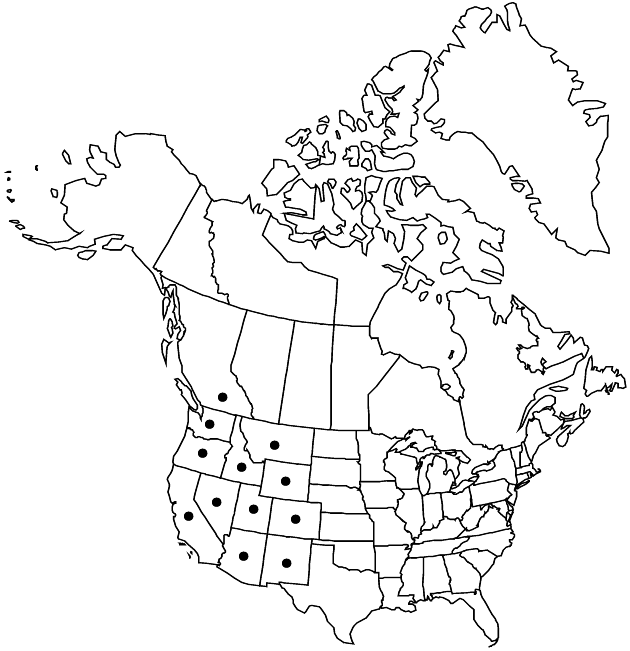Difference between revisions of "Brickellia oblongifolia"
Trans Amer. Philos. Soc., n. s. 7: 288. 1840.
FNA>Volume Importer |
RevisionBot (talk | contribs) m (Bot: Adding category Revised Since Print) |
||
| (3 intermediate revisions by 2 users not shown) | |||
| Line 6: | Line 6: | ||
|place=7: 288. 1840 | |place=7: 288. 1840 | ||
|year=1840 | |year=1840 | ||
| + | }} | ||
| + | |special_status={{Treatment/ID/Special_status | ||
| + | |code=F | ||
| + | |label=Illustrated | ||
| + | }}{{Treatment/ID/Special_status | ||
| + | |code=E | ||
| + | |label=Endemic | ||
}} | }} | ||
|basionyms= | |basionyms= | ||
| Line 19: | Line 26: | ||
-->{{Treatment/Body | -->{{Treatment/Body | ||
| − | |distribution= | + | |distribution=B.C.;Ariz.;Calif.;Colo.;Idaho;Mont.;N.Mex.;Nev.;Oreg.;Utah;Wash.;Wyo. |
|discussion=<p>Varieties 2 (2 in the flora).</p> | |discussion=<p>Varieties 2 (2 in the flora).</p> | ||
|tables= | |tables= | ||
| Line 49: | Line 56: | ||
|basionyms= | |basionyms= | ||
|family=Asteraceae | |family=Asteraceae | ||
| − | |distribution= | + | |distribution=B.C.;Ariz.;Calif.;Colo.;Idaho;Mont.;N.Mex.;Nev.;Oreg.;Utah;Wash.;Wyo. |
|reference=None | |reference=None | ||
|publication title=Trans Amer. Philos. Soc., n. s. | |publication title=Trans Amer. Philos. Soc., n. s. | ||
|publication year=1840 | |publication year=1840 | ||
| − | |special status= | + | |special status=Illustrated;Endemic |
| − | |source xml=https:// | + | |source xml=https://bitbucket.org/aafc-mbb/fna-data-curation/src/2e0870ddd59836b60bcf96646a41e87ea5a5943a/coarse_grained_fna_xml/V19-20-21/V21_1282.xml |
|tribe=Asteraceae tribe Eupatorieae | |tribe=Asteraceae tribe Eupatorieae | ||
|genus=Brickellia | |genus=Brickellia | ||
| Line 60: | Line 67: | ||
}}<!-- | }}<!-- | ||
| − | -->[[Category:Treatment]][[Category:Brickellia]] | + | --> |
| + | |||
| + | [[Category:Treatment]] | ||
| + | [[Category:Brickellia]] | ||
| + | [[Category:Revised Since Print]] | ||
Latest revision as of 18:30, 6 November 2020
Perennials or subshrubs, 10–60 cm (caudices woody). Stems branched, stipitate-glandular to glandular-pubescent. Leaves mostly alternate (sometimes subopposite); petioles 0; blades obscurely 3-nerved from bases, elliptic, lance-linear, or oblong, 9–40 × 1–15 mm, bases acute to attenuate, margins entire, apices acute or obtuse, faces pubescent to villous, often stipitate-glandular. Heads borne singly or in corymbiform arrays. Peduncles 2–50 mm, glandular-pubescent. Involucres cylindric to campanulate, 10–20 mm. Phyllaries 25–35 in 4–6 series, greenish, 4–5-striate, unequal, margins scarious (sometimes ciliate, apices acute to acuminate); outer ovate to lanceolate (gland-dotted to glandular-puberulent), inner linear-lanceolate to linear (glabrous). Florets 25–50; corollas pale yellow-green or cream, often purple-tinged, 5–10 mm. Cypselae 3–7 mm, stipitate-glandular or hispidulous; pappi of 18–25 white, barbellate to subplumose bristles.
Distribution

B.C., Ariz., Calif., Colo., Idaho, Mont., N.Mex., Nev., Oreg., Utah, Wash., Wyo.
Discussion
Varieties 2 (2 in the flora).
Selected References
None.
Key
| 1 | Cypselae usually stipitate-glandular, sometimeshispidulous | Brickellia oblongifolia var. oblongifolia |
| 1 | Cypselae setose-hispidulous, mostly lacking glands | Brickellia oblongifolia var. linifolia |